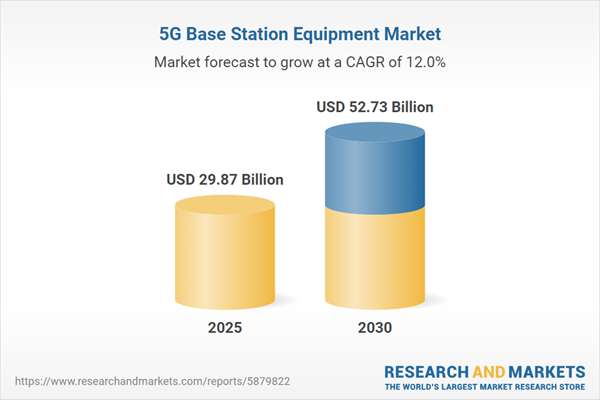The 5G base station equipment market is estimated to reach US$52.733 billion by 2030 from US$29.865 billion in 2025, growing at a CAGR of 12.04%.
5G base stations form the backbone of next-generation wireless networks, enabling enhanced bandwidth, ultra-low latency, and broader coverage to support rising connectivity demands. Driven by surging smartphone adoption (78% global mobile ownership in 2023, per ITU) and escalating internet usage, the market is poised for robust growth. Urban areas, where 81% of populations use the internet (vs. 50% in rural regions), are key deployment hubs, fueled by denser network requirements and rapid urbanization.
5G base stations form the backbone of next-generation wireless networks, enabling enhanced bandwidth, ultra-low latency, and broader coverage to support rising connectivity demands. Driven by surging smartphone adoption (78% global mobile ownership in 2023, per ITU) and escalating internet usage, the market is poised for robust growth. Urban areas, where 81% of populations use the internet (vs. 50% in rural regions), are key deployment hubs, fueled by denser network requirements and rapid urbanization.
Key Growth Drivers
- Urbanization & Internet Penetration: Global urban populations grew from 4.46 billion (2021) to 4.61 billion (2023), intensifying demand for high-speed connectivity. Europe leads in internet adoption (92%), followed by the Americas (90%) and Asia-Pacific (80%).
- Smartphone & Data Demand: Rising mobile device usage for internet access, particularly in emerging economies, necessitates 5G infrastructure upgrades to manage traffic and user expectations.
Geographical Insights
- Asia-Pacific dominates growth, led by India’s aggressive 5G rollout. The country achieved 90% 5G coverage in 2023, supported by government initiatives like indigenous telecom development funds, spectrum auctions, and test beds. India’s 5G sector is projected to contribute $455 billion to its economy by 2024.
- Mobile-First Trends: With 82% of India’s internet access via mobile devices, the region exemplifies the link between smartphone dependency and 5G infrastructure demand.
Future Outlook
Government policies, such as India’s 2030 5G roadmap, and global urbanization trends will continue to drive investments in base station equipment. This infrastructure is critical to meeting the dual demands of expanding connectivity and supporting next-gen applications like IoT and smart cities.Reasons for buying this report:
- Insightful Analysis: Gain detailed market insights covering major as well as emerging geographical regions, focusing on customer segments, government policies and socio-economic factors, consumer preferences, industry verticals, other sub-segments.
- Competitive Landscape: Understand the strategic maneuvers employed by key players globally to understand possible market penetration with the correct strategy.
- Market Drivers & Future Trends: Explore the dynamic factors and pivotal market trends and how they will shape up future market developments.
- Actionable Recommendations: Utilize the insights to exercise strategic decision to uncover new business streams and revenues in a dynamic environment.
- Caters to a Wide Audience: Beneficial and cost-effective for startups, research institutions, consultants, SMEs, and large enterprises.
What do businesses use our reports for?
Industry and Market Insights, Opportunity Assessment, Product Demand Forecasting, Market Entry Strategy, Geographical Expansion, Capital Investment Decisions, Regulatory Framework & Implications, New Product Development, Competitive Intelligence.Report Coverage:
- Historical data & forecasts from 2022 to 2030
- Growth Opportunities, Challenges, Supply Chain Outlook, Regulatory Framework, Customer Behaviour, and Trend Analysis
- Competitive Positioning, Strategies, and Market Share Analysis
- Revenue Growth and Forecast Assessment of segments and regions including countries
- Company Profiling (Strategies, Products, Financial Information, and Key Developments among others)
The 5G base station equipment market has been segmented as following:
- By Deployment
- Urban
- Rural
- By Architecture
- AAU
- BBU
- By Technology
- O-RAN
- Traditional RAN
- By Configuration
- Standalone
- Non-Standalone
- By Frequency Band
- Sub-6-Ghz
- mmWave
- By Geography
- North America
- United States
- Canada
- Mexico
- South America
- Brazil
- Argentina
- Others
- Europe
- United Kingdom
- Germany
- France
- Italy
- Spain
- Others
- Middle East and Africa
- Saudi Arabia
- UAE
- Others
- Asia Pacific Region
- China
- Japan
- South Korea
- India
- Indonesia
- Thailand
- Taiwan
- Others
- North America
Table of Contents
1. INTRODUCTION
2. RESEARCH METHODOLOGY
3. EXECUTIVE SUMMARY
4. MARKET DYNAMICS
5. 5G BASE STATION EQUIPMENT MARKET BY DEPLOYMENT
6. 5G BASE STATION EQUIPMENT MARKET BY ARCHITECTURE
7. 5G BASE STATION EQUIPMENT MARKET BY TECHNOLOGY
8. 5G BASE STATION EQUIPMENT MARKET BY CONFIGURATION
9. 5G BASE STATION EQUIPMENT MARKET BY FREQUENCY BAND
10. 5G BASE STATION EQUIPMENT MARKET BY GEOGRAPHY
11. COMPETITIVE ENVIRONMENT AND ANALYSIS
12. COMPANY PROFILES
Companies Mentioned
- NEC
- Fujitsu
- Huawei Technologies Co., Ltd.
- Samsung
- ZTE
- Nokia
- Ericsson
- Intel
- 3M
- WiSig Networks Pvt. Ltd.
- Murata Manufacturing Co.
- Mavenir
- Cisco Systems, Inc.
Methodology

LOADING...
Table Information
| Report Attribute | Details |
|---|---|
| No. of Pages | 138 |
| Published | January 2025 |
| Forecast Period | 2025 - 2030 |
| Estimated Market Value ( USD | $ 29.87 Billion |
| Forecasted Market Value ( USD | $ 52.73 Billion |
| Compound Annual Growth Rate | 12.0% |
| Regions Covered | Global |
| No. of Companies Mentioned | 13 |









